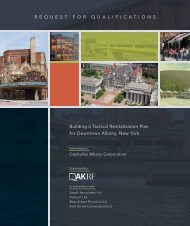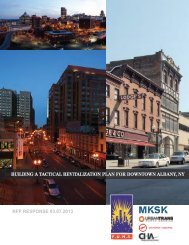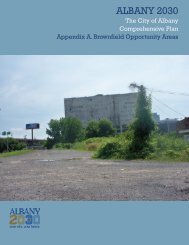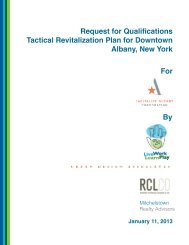TACTICAL REVITALIZATION PLAN FOR DOWNTOWN ALBANY NY
tactical revitalization plan for downtown albany, ny - Capitalize ...
tactical revitalization plan for downtown albany, ny - Capitalize ...
Create successful ePaper yourself
Turn your PDF publications into a flip-book with our unique Google optimized e-Paper software.
Section 2<br />
B) Harnessing ‘Redundant’ but Usable Internal Space Downtown<br />
Of the many challenges to downtowns, the “glut” of secondary and outdated office space is<br />
a frequently cited issue. We will build an inventory of unique typologies of available space,<br />
such as underutilized Class B and C office space. These spaces are constrained by critical<br />
dimensions of their floor plates and ceiling heights, as well as access to light and views. In<br />
spite of their nonconformity, no two buildings are alike and this is part of their charm. These<br />
spaces – while often seen as a problem when vacant or underutilized – can become key<br />
elements of a downtown revitalization strategy, as they present low barriers (lower cost than<br />
new construction) to increasing residential population or attracting creative industries and<br />
start-ups to unusual spaces that have character and patina. In addition, they often are of<br />
a manageable size that can, utilizing a variety of layered financing and tax incentives for<br />
rehabilitation, be feasibly redeveloped into mixed-use projects.<br />
Activating unused floorspace within the downtown for new residents and employers is<br />
ultimately the driver of future retail development. More residents and employers in the<br />
downtown will drive retail activity, in turn attracting more visitors to enjoy the unique offerings<br />
in a downtown. Recruiting successful, but unique, region-based businesses has often been<br />
demonstrated to be a more successful strategy than focusing on attracting entirely new<br />
businesses, especially as those more local businesses know the regional market and can tweak<br />
the product for a more urban clientele, as well as employ customer loyalty. Providing available<br />
space at reasonable lease terms with adequate tenant improvement allowances is a challenge,<br />
and strategies such as master leasing can be created by downtown entities to match up<br />
interested retailers with appropriate space.<br />
We see these spaces as potential sites identified for tactical interventions. A variety of<br />
installments or uses will be examined as part of our experience design process.<br />
C) Managing Parking Demand and Making Albany a Smarter Transit Hub<br />
Parking can be a persistent problem in downtowns, and an adequate supply must be in place,<br />
but it is frequently an issue of perception and one that usually demands a better system of<br />
management, than a real need for additional spaces. Management of parking is the first order<br />
priority for a Business Improvement District and new technologies, such as smart phone apps<br />
or smart charge cards, can help support innovative policies, increase revenue for the city and<br />
improve perceptions of parking scarcity.<br />
Improvement of the public realm can also reduce the perceptions of distance that poor<br />
conditions create. Better lighting, sidewalks, wayfinding and active storefronts alter the<br />
perceived distance so that walking a block or two is seen as pleasure rather than an<br />
impediment for patrons. In addition, innovative public/private mixed use projects that<br />
incorporate parking is one way of both providing additional parking and reducing the costs of<br />
private development, a win/win situation.<br />
Parking provision should be examined in parallel with assessing the city’s wider transportation,<br />
public health and environmental goals. This would present an ideal time to marry the








